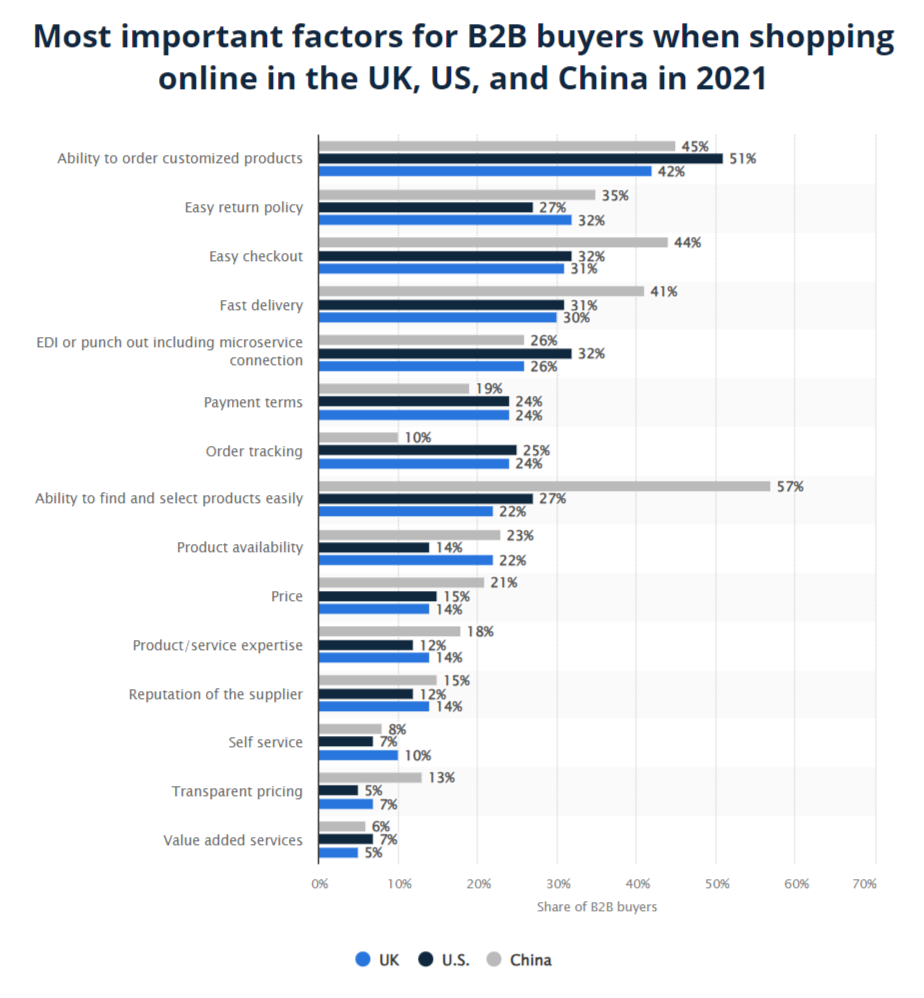(631) 486-7589

You have a successful direct to consumer (DTC) brand with a swarm of customers who love the novel experiences you provide. However, things are... static on the business to business (B2B) side of your ecommerce firm.
According to studies, 90% of B2B buyers want DTC-style experiences from the suppliers they buy from, yet more than half are disappointed when companies fail to meet these expectations.
This push can be attributed in part to the changing demographics of B2B buyers. According to Forrester, millennials influence 73% of B2B purchasing decisions. Millennials have grown up with technology and expect self-service, personalized, and frictionless consumer journeys, whether they are purchasing for themselves or their organization. What is the end result for brands that provide this B2B experience? The primary drivers of growth are new client acquisition and lifetime value (LTV).
DTC-ifying your B2B shop enables you to deliver on these promises while also giving business buyers with frictionless experiences that persuade them to continue purchasing. This guide will show you how.
What does it mean to “DTC-ify” B2B ecommerce?
B2B ecommerce is becoming more consumer-oriented. Because millennials have purchasing power within businesses, a whopping 90% of B2B buyers want to be marketed to by the vendors they buy from.
“DTC-ifying B2B experiences means bridging the gap between the modern online shopping experience and traditional B2B purchasing methods. That could mean providing more personalization options, offering better discounts, or faster shipping options. It's about understanding business buyers' needs and delivering on them in a way that's appropriate for their unique situation.” —David Zhang, CEO of Kate Backdrop
To DTC-ify B2B ecommerce simply means to deliver a smooth and personalized ecommerce experience for customers. It satisfies your consumers' desire for one-stop access to all of their critical data (items, pricing, orders, and account information), while also allowing them to connect with and create a relationship with your business.
In the short and long term, outdated means of B2B sales, such as phone, email, or sales rep interactions, can often lead to a larger chance of losing orders. Physical orders can become misplaced. Important team members with important customer knowledge may quit in favor of competition. When you wish to reach a national or worldwide audience, traditional selling methods rely on others to complete the transaction and are often not scalable. Ecommerce, on the other hand, is driven by the wants of your purchasers and is available to all of your clients 24 hours a day, seven days a week.
And the disadvantages of not giving this experience are obvious. Almost a quarter of B2B buyers have switched vendors as a result of a single unpleasant internet encounter. However, by incorporating DTC trends into your B2B operation, you may get closer to your clients by providing tailored experiences that generate easy conversion at scale.
Why does B2B require DTC expertise?
DTC-ifying the B2B client experience may appear to be an unneeded burden. After all, the B2B ecommerce business has evolved significantly in the recent decade. Is it actually in need of further innovation?
The quick answer is yes. Let's take a closer look at why consumerizing B2B sales gives you a competitive advantage.
Boost conversion
Perhaps most crucially, an excellent purchase experience—one that adds DTC-style functionality and gives buyers with the online experiences they're accustomed to—will help you win business and attract new B2B clients.
A tailored shopping experience allows you to engage with your existing customers more effectively and encourage them to place repeat buys. According to studies, 60% of customers believe their supplier's ecommerce experience is extremely crucial to their relationship with the source. Another 67% have switched vendors in order to provide a more "consumer-like" experience.
“By creating an experience that mirrors the convenience and personalization of DTC retailers, businesses can give their buyers a better shopping experience. This can lead to increased loyalty, repeat purchases, and higher sales.” —Aaron Jerez, founder and CEO of Home Bar Select
Make time for yourself and your customers.
Customers can do more in less time with great ecommerce sites. Customers conducting both B2B and DTC purchases will abandon merchants who need a significant time investment in favor of competitors who provide a more streamlined buying process with less friction.
Merchants benefit from streamlined, efficient ecommerce solutions as well. Internal time and resource savings result in improved profit margins and increased income.
You will spend more time on strategic initiatives and less time on back office activities if you DTC-ify the purchase experience for wholesale customers. Furthermore, by automating more of your internal procedures, you can reduce human error.
Increase brand loyalty and awareness.
For years, DTC businesses have benefited from stunning, creative websites and design.
With minimal lift, excellent branding will help you differentiate your organization from other competitors on the market.
Stand out from the crowd.
A mere internet presence is no longer sufficient to compete. According to a recent McKinsey analysis, "it's not enough for B2B companies to meet this moment; they also need to prepare for the next one: delivering consistent, exceptional experiences across the omnichannel ecosystem."
Statista data demonstrates that B2B buyers seek numerous DTC-style capabilities from the B2B companies they buy from online. The ability to order personalized products, browse availability, and track orders was high on their priority list—yet more than half are dissatisfied with the present online experiences.

What features or functionality support this modification?
Personalization and customization
Buyer expectations of online experiences are rising as ecommerce becomes more prevalent in everyday life. Approximately seven out of ten consumers are trained to seek out tailored experiences, and organizations that thrive at personalisation generate 40% more income than their typical competitors.
Apply the same logic to your B2B ecommerce approach to get a comparable return on investment (ROI). Proactively, rather than reactively, give buyers with individualized experiences at all touchpoints. This includes the following:
- Catalogs of customized products. Curating the products and pricing your consumers see online is critical to B2B ecommerce success, as buyers often spend little time on your site and deal with multiple suppliers. Customer-specific product posting, quantity limitations for product purchasing, and customizable price and payment conditions enable you to customise the purchasing experience and better connect your customers.
- Branding tweaks and design, as well as a consistent experience across all platforms, can help you increase brand awareness and loyalty.
- Options for multiple currencies and languages. Modern B2B ecommerce is global—you are not limited to buyers in your own country. Expand your business abroad by using a platform that can enable currency and language localization for all of your clients.
- Product recommendations and reviews. Customers want to see themselves in the campaigns they're viewing, as well as hear from other customers who have purchased the things you're selling. Connecting with your customers via curated product suggestions and peer evaluations fosters trust in your company and allows you to develop deeper relationships with them.
“One of the biggest priorities for us was to make sure both parts of the business—DTC and B2B—felt unified. Same brand, same website, same quality, and most importantly same service. The biggest mistake I think companies make is trying to separate the two. The more a company can integrate both types of offerings, the better off they will be in the long term!” —Colin Barceloux, CEO of Lively Root
Automation and self-service
You and your buyers will save time while addressing a major sales obstacle in B2B purchase decisions: simplicity of purchase. The easier it is for a customer to buy from you, the less time they have to second-guess their purchase and the more likely they are to buy from you again in the future.
The greatest ecommerce platforms will allow customers to place orders at any time and control their own account, including access to their specific price, items, payment terms, and more. Your customers desire the ability to self-serve without having to contact sales or support.
- Credit cards were vaulted. Allow buyers to vault their credit card at checkout or in their self-service account center, and charge their card on file as payments are due. You are paid on time, every time—no chasing necessary.
- Reminders to pay. In contrast to DTC, B2B payments are frequently made significantly later in the purchase cycle, with Net 30, 45, or 60-day periods. Instead than having your sales team set mental reminders and manually email consumers with payment data, remind them when their payment is due or overdue.
- Quantity is everything. Because they buy in larger numbers, wholesale clients benefit from lower prices. Set purchase criteria to boost average order values and streamline your fulfillment process. Before adding an item to their cart, customers see the minimum, maximum, or increment (e.g. case pack, multiple) quantity required.
- Integrations with ERP and API. Integrate with ERP vendors such as Brightpearl, Acumatica, and NetSuite to automate your back-end processes. It will connect critical business data from both DTC and B2B sales channels, allowing you to manage pricing, customers, price lists, and inventory without human entry and ensuring your customers have access to the most up-to-date information.
Automation benefits everyone, not just merchants. Buyers can make use of:
- Reordering is simple. Allow purchasers to effortlessly repeat previous orders, make changes, and recheckout with a few clicks. Reordering options make the ordering process easier for your customers and encourage repeat purchases.
- Account information is editable. According to Gartner, the average B2B purchasing decision involves 6 to 10 stakeholders. Accelerate internal purchasing and make it simple for customers to maintain their accounts by giving them access to all of their corporate information through their ecommerce site. Set separate permission levels for distinct clients, so that only those with admin access can modify critical information.
- Payment reminders and "Pay Now" buttons on previous orders. Customers will never be unaware when their payments are due. Customers may maintain good standing with their suppliers and establish stronger merchant relationships by receiving payment reminders and the ability to pay down purchases when their payments become due.
While the majority of your sales and support contacts can be automated, employ self-service and automation as your initial point of contact, with a professional B2B sales team as backup. It will filter out support tickets that do not require human intervention, giving your team more time to establish connections rather than B2B processing orders.
Payment and ordering flexibility
The payments for B2B and DTC orders differ considerably. The latter is quick and easy; money is paid in advance before a single customer's request is completed. Business buyers, on the other hand, have more influence over the methods and solutions available to them.
Provide DTC treatment to B2B.
Business clients want the same personalized, smooth shopping experiences they get when purchasing personal items.
Let's Get to Work.
Have an unsolvable problem or audacious idea?
